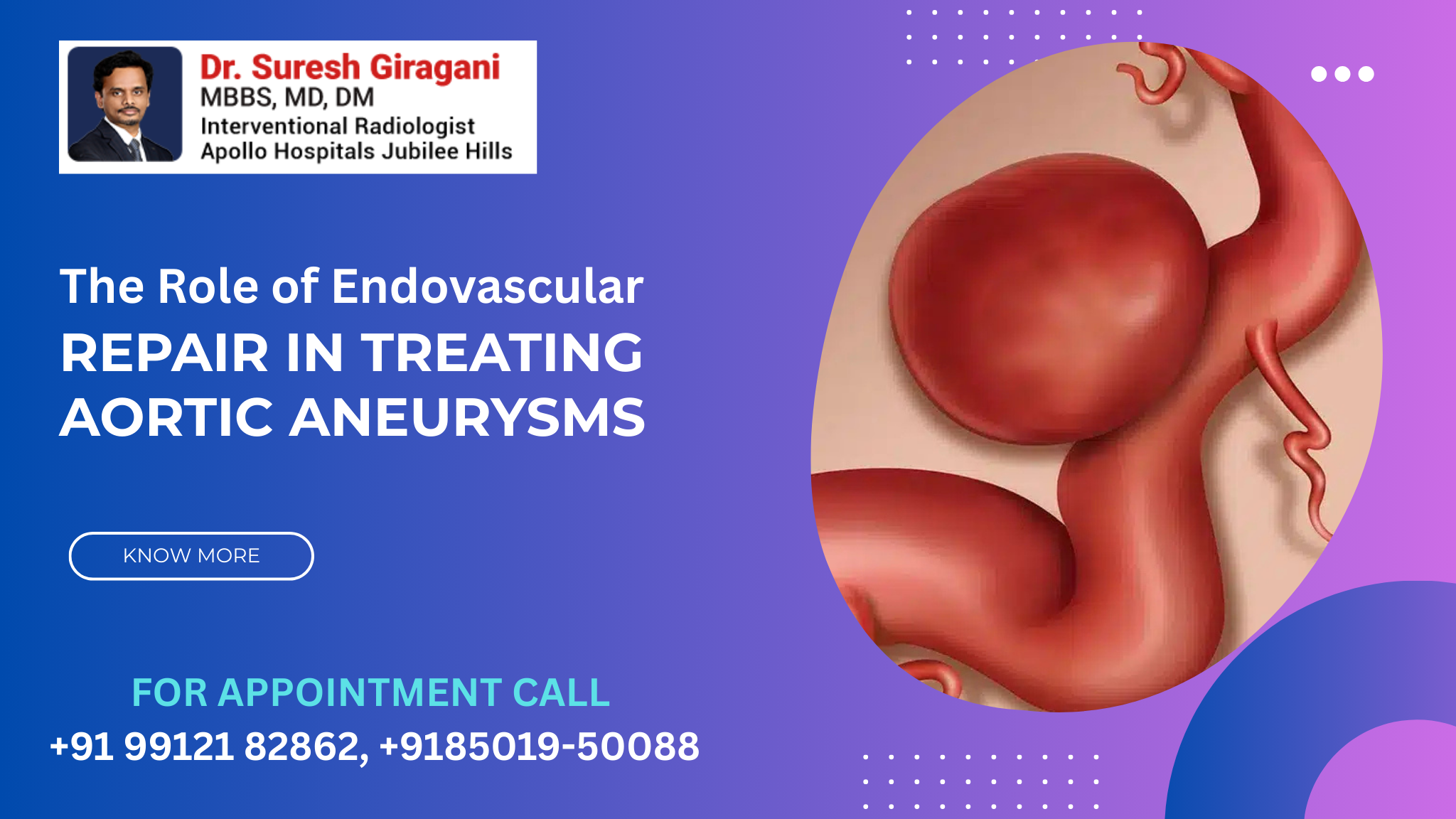
The Role of Endovascular Repair in Treating Aortic Aneurysms

Aortic aneurysms are a serious health concern that can lead to life-threatening complications if not detected and treated early. Traditionally, the treatment of aortic aneurysms involved invasive surgeries, but with the advancements in medical technology, a minimally invasive approach known as Endovascular Repair has become a game-changer. This blog will explore how interventional radiology plays a crucial role in the management and treatment of aortic aneurysms, offering patients a safer and less invasive alternative to traditional surgery.
What Is an Aortic Aneurysm?
An aortic aneurysm is the abnormal bulging or weakening of the walls of the aorta. As the aneurysm grows, the pressure from blood flow can cause further weakening of the aortic wall, which may eventually lead to a rupture. Aortic aneurysms can occur in any part of the aorta, but the two most common types are abdominal and thoracic aneurysms:
- Abdominal Aortic Aneurysm (AAA): This occurs in the section of the aorta that passes through the abdomen. It is more common in older adults, particularly men, and can be difficult to detect since it may not show symptoms until it is too late.
- Thoracic Aortic Aneurysm (TAA): This occurs in the upper portion of the aorta, near the chest. While less common than AAA, TAA is equally dangerous and can cause symptoms like chest pain, back pain, or shortness of breath.
Traditional Treatment Options for Aortic Aneurysms
For many years, the only treatment for an aortic aneurysm was open surgery. This procedure involved making a large incision, removing the damaged portion of the aorta, and replacing it with a synthetic graft. Although this approach is still used for certain cases, it carries several risks, including complications from anesthesia, blood loss, and prolonged recovery times. Additionally, patients with other underlying health conditions or advanced age may not be suitable candidates for open surgery due to the risks involved.
Endovascular Repair in Treating Aortic Aneurysms
In recent years, Endovascular Repair has revolutionized the treatment of aortic aneurysms, particularly for patients who may not be suitable candidates for open surgery due to age, health conditions, or other factors. The most common interventional radiology procedure for aortic aneurysms is endovascular aneurysm repair (EVAR).
1. Endovascular Aneurysm Repair (EVAR)
EVAR is a minimally invasive procedure that allows doctors to repair an aortic aneurysm without the need for major surgery. During EVAR, an interventional radiologist will insert a catheter into a small incision, typically in the groin. Using real-time imaging, the radiologist guides the catheter to the site of the aneurysm in the aorta. A stent graft (a small tube made of fabric and metal) is then placed inside the aorta to reinforce the weakened wall and prevent rupture.
The procedure typically takes a few hours, and because it is minimally invasive, patients experience less pain and a much quicker recovery time compared to traditional surgery. Most patients can go home the same day or after a short stay in the hospital.
2. Thoracic Endovascular Aortic Repair (TEVAR)
For thoracic aortic aneurysms, a similar procedure called thoracic endovascular aortic repair (TEVAR) is used. TEVAR involves inserting a stent graft into the thoracic aorta through a catheter, which helps stabilize the aortic wall and prevent further expansion of the aneurysm. This technique is also highly effective and carries a lower risk of complications than open surgery.
3. Monitoring and Follow-Up
After an interventional radiology procedure like EVAR or TEVAR, patients are closely monitored through regular imaging tests to ensure that the stent graft is functioning properly and the aneurysm is stable. In some cases, the procedure may need to be repeated if there are signs of complications, but the overall success rate of these minimally invasive techniques is high.
Benefits of Interventional Radiology for Aortic Aneurysms
- Minimally Invasive: Interventional radiology procedures require only small incisions, reducing the risk of infection and scarring.
- Shorter Recovery Time: Patients who undergo EVAR or TEVAR typically experience faster recovery times, with many returning to normal activities in just a few weeks.
- Reduced Risk: For high-risk patients who may not be candidates for open surgery, interventional radiology offers a safer alternative with fewer complications.
- Precise and Targeted: Using advanced imaging techniques, interventional radiologists can navigate the aneurysm site with precision, ensuring accurate placement of stents and grafts.
- Fewer Complications: The risk of complications like blood loss, infection, or prolonged hospitalization is significantly reduced with interventional radiology procedures.
Who Is a Candidate for Interventional Radiology?
Interventional radiology procedures, such as EVAR and TEVAR, are suitable for a wide range of patients, including those who are elderly, have other underlying health conditions, or have previously undergone unsuccessful surgical repairs. However, not every aneurysm is appropriate for endovascular repair. The suitability of these treatments depends on factors such as the size, location, and shape of the aneurysm, as well as the patient’s overall health.
Conclusion:
Endovascular Repair has transformed the way aortic aneurysms are treated, offering patients a less invasive, safer, and faster alternative to traditional surgery. With procedures like EVAR and TEVAR, patients can experience faster recovery times, fewer risks, and a better quality of life after treatment. If you or someone you know is at risk for an aortic aneurysm, consult with a specialist like Dr. Suresh Giragani, the best Neuro Interventional Radiologist in Hyderabad, to learn more about the available treatment options and whether interventional radiology could be the right choice for you.
By offering a cutting-edge, minimally invasive approach, interventional radiology is proving to be a vital tool in the fight against aortic aneurysms, saving lives and improving outcomes for many patients around the world.
About the Author:

Name: DR . SURESH GIRAGANI
INTERVENTIONAL RADIOLOGIST
DR. SURESH GIRAGANI CONSULTANT INTERVENTIONAL RADIOLOGIST at Apollo hospitals Jubilee Hills has more than sixteen years of clinical experience in vascular interventions with a special interest in neurovascular and peripheral vascular disease interventional procedures.